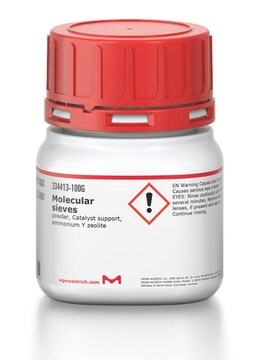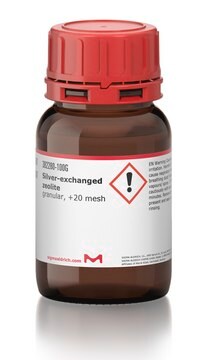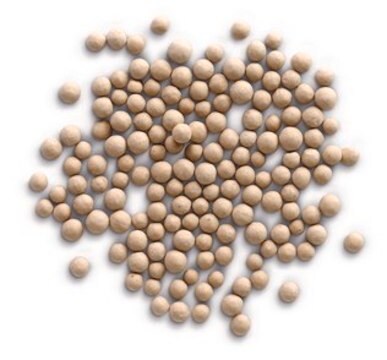96096
Zeolite
Sinonimo/i:
Aluminosilicate
Autenticatiper visualizzare i prezzi riservati alla tua organizzazione & contrattuali
About This Item
Prodotti consigliati
Cerchi prodotti simili? Visita Guida al confronto tra prodotti
Descrizione generale
Choosing a Molecular Sieve:
1. The preferential adsorption of one molecule over another depends upon pore diameter and mesh size.
2. The dynamic capacity of the silica gel for adsorbing a particular compound is governed by the internal surface area; the greater the surface area, the greater the dynamic capacity.
3. Rate of adsorption and sharpness of resolution are dependent chiefly on particle size and column packing; a fine particle size gives optimum sharpness of resolution.
4. Liquids are most readily adsorbed from solvents in which they are least soluble; a good solvent makes a good desorbing agent.
5. Highly polar liquids are readily adsorbed. Compounds having hydroxyl groups, or containing oxygen are strongly adsorbed.
6. For similar compounds, the higher the molecular weight the higher the selectivity.
7. For hydrocarbons of similar molecular weight, adsorptivity increases with the number of double bonds.
1. The preferential adsorption of one molecule over another depends upon pore diameter and mesh size.
2. The dynamic capacity of the silica gel for adsorbing a particular compound is governed by the internal surface area; the greater the surface area, the greater the dynamic capacity.
3. Rate of adsorption and sharpness of resolution are dependent chiefly on particle size and column packing; a fine particle size gives optimum sharpness of resolution.
4. Liquids are most readily adsorbed from solvents in which they are least soluble; a good solvent makes a good desorbing agent.
5. Highly polar liquids are readily adsorbed. Compounds having hydroxyl groups, or containing oxygen are strongly adsorbed.
6. For similar compounds, the higher the molecular weight the higher the selectivity.
7. For hydrocarbons of similar molecular weight, adsorptivity increases with the number of double bonds.
Regeneration or Activation:
A saturated molecular sieve can be restored to its original capacity by regeneration, the principle of which involves changing the conditions surrounding the adsorbent to correspond to a very low equilibrium capacity. In general, the greater the difference between the equilibrium capacities of adsorption and regeneration, the more rapid and complete the regeneration.
The sieve may be regenerated in one of four ways:
1. Thermal reactivation –The maximum regeneration temperature for Silica is 300°C.
2. Pressure reactivation
3. Passing an appropriate fluid through the gel bed at normal temperature and pressure.
4. Displacement of adsorbates by passing a high concentration of molecules in a fluid through the bed.
A saturated molecular sieve can be restored to its original capacity by regeneration, the principle of which involves changing the conditions surrounding the adsorbent to correspond to a very low equilibrium capacity. In general, the greater the difference between the equilibrium capacities of adsorption and regeneration, the more rapid and complete the regeneration.
The sieve may be regenerated in one of four ways:
1. Thermal reactivation –The maximum regeneration temperature for Silica is 300°C.
2. Pressure reactivation
3. Passing an appropriate fluid through the gel bed at normal temperature and pressure.
4. Displacement of adsorbates by passing a high concentration of molecules in a fluid through the bed.
Applicazioni
Zeolite, a microporous, aluminosilicate mineral, is used as a molecular sieve and as an adsorbent of a wide variety of cations, such as Na+, K+, Ca2+, Mg2+ and others. Zeolite is used in the development of a variety of bioreactor devices.
Altre note
In the determination of serum triglycerides
Codice della classe di stoccaggio
11 - Combustible Solids
Classe di pericolosità dell'acqua (WGK)
nwg
Punto d’infiammabilità (°F)
Not applicable
Punto d’infiammabilità (°C)
Not applicable
Dispositivi di protezione individuale
Eyeshields, Gloves, type N95 (US)
Certificati d'analisi (COA)
Cerca il Certificati d'analisi (COA) digitando il numero di lotto/batch corrispondente. I numeri di lotto o di batch sono stampati sull'etichetta dei prodotti dopo la parola ‘Lotto’ o ‘Batch’.
Possiedi già questo prodotto?
I documenti relativi ai prodotti acquistati recentemente sono disponibili nell’Archivio dei documenti.
Benzylimidazolium cations as zeolite structure-directing agents. Differences in performance brought about by a small change in size.
Rojas A, Gomez-Hortiguela L, Camblor MA.
Dalton Transactions (2012)
Lactic acid production on liquid distillery stillage by Lactobacillus rhamnosus immobilized onto zeolite.
Djukic-Vukovic AP, Mojovic LV, Jokic BM, et al.
Bioresource Technology (2012)
Thomas Simons et al.
Beilstein journal of nanotechnology, 3, 667-673 (2012-12-06)
In a proof-of-concept study we demonstrate in situ reaction monitoring of DeNO(x)-SCR on proton-conducting zeolites serving as catalyst and gas sensor at the same time. By means of temperature-dependent impedance spectroscopy we found that the thermally induced NH(3) desorption in
Mehran Andalib et al.
Bioresource technology, 121, 411-418 (2012-08-07)
The primary objective of this work was to investigate the treatability of thin stillage as a by-product of bioethanol production plants using an anaerobic fluidized bed bioreactor (AFBR) employing zeolite with average diameter of (d(m)) of 425-610 μm and specific
C Mery et al.
Journal of environmental science and health. Part A, Toxic/hazardous substances & environmental engineering, 47(3), 420-427 (2012-02-11)
An evaluation of natural zeolite as a microorganism carrier in nitrifying reactors operated in batch mode was carried out. Specifically, the influence of zeolite particle sizes of 0.5, 1.0 and 2.0 mm in diameter on microorganism adherence to zeolite, ammonium
Il team dei nostri ricercatori vanta grande esperienza in tutte le aree della ricerca quali Life Science, scienza dei materiali, sintesi chimica, cromatografia, discipline analitiche, ecc..
Contatta l'Assistenza Tecnica.





